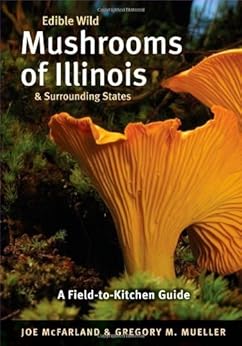 It isn't often that a field guide to wild edible plants is readable for pure entertainment value, but such is the case with Edible Wild Mushrooms of Illinois & Surrounding States, by Joe McFarland and Gregory M. Mueller. I was not at all interested in reading this book that Bad Assed Husband (BAH) has been toting around lately while gazing at the ground, until he started reading aloud from it for Little Z's bedtime story. Little Z and I were both riveted, on the edge of our seats, as BAH read us the passage describing the experience of eating a Wood Ear mushroom,
It isn't often that a field guide to wild edible plants is readable for pure entertainment value, but such is the case with Edible Wild Mushrooms of Illinois & Surrounding States, by Joe McFarland and Gregory M. Mueller. I was not at all interested in reading this book that Bad Assed Husband (BAH) has been toting around lately while gazing at the ground, until he started reading aloud from it for Little Z's bedtime story. Little Z and I were both riveted, on the edge of our seats, as BAH read us the passage describing the experience of eating a Wood Ear mushroom,"The Wood Ear rehydrates just fine and becomes a perfectly edible mushroom you can share with dinner guests while serving Asian dishes. 'Interesting texture' is how generous people describe the Wood Ear, before taking a drink...
"The flavor of Auricularia auricula-judae is not foul, nor is it good. We'd like to describe the flavor properly but it really has no flavor, as far as we can tell. Perhaps meditation will provide answers, or eliminate the question altogether."
Then, lest you should think that wild mushrooms don't taste good, BAH read a bit for us about the Lion's Mane, page 59,
"It [Lion's Mane] has a surprisingly mild, totally inoffensive tendency to actually taste a bit like crab or lobster meat, mild and sweetly tender, which is a culinary description rarely assigned to mushrooms. Hericium erinaceus, therefore, is a good example of why people should try a few different species of mushrooms in their life before deciding they don't like mushrooms. It's like being opposed to music based on a specific hatred of the zither."
The photographs are wonderful, too. And, if you happen to live anywhere near Illinois, you could even use this book to find some wild edibles. Or, read it to a child at bedtime. Edible Wild Mushrooms of Illinois & Surrounding States has multiple uses. Highly recommended.

Chanterelle mushrooms are wonderful. The only mushroom I trust myself to safely pick and eat; unfortunately they're so valuable it's virtually impossible to find them. They love to associate with Canyon Oaks, growing under the leafy canopy in the moist leaf mold there...and often where a lot of poison oak grows as well, so wearing appropriate clothing is important.
ReplyDeleteI've never had a Chanterelle! We have noticed that all of the best mushrooms grow under Oak trees, so we have located all of the surrounding Oak trees, and we are now waiting for rain. I love Oak trees. There's one I have to take a picture of for this blog. It is so incredibly old. There is this old, old fence pressed tightly up against it. It must be the fence someone put up to protect it from deer when they planted it a hundred years ago.
ReplyDelete